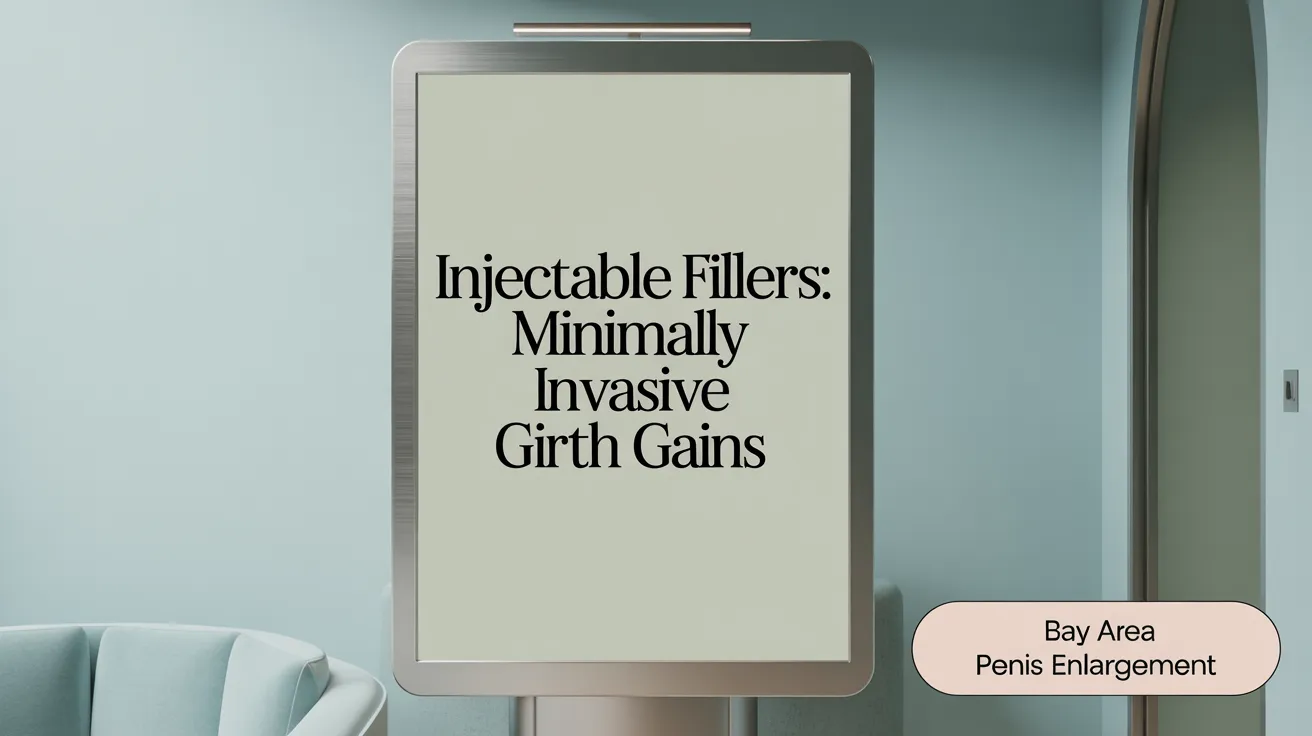Understanding the Drive Behind Penile Enhancement
The quest to enhance penile length and girth is influenced by a complex interplay of cultural pressures, psychological factors, and advances in medical science. Increasingly, men with healthy, normal penile dimensions seek augmentation procedures, driven by societal ideals of masculinity and self-esteem concerns. This article delves into the spectrum of available options, both surgical and nonsurgical, highlighting their effectiveness, safety, and potential risks to help readers navigate this sensitive subject with clarity and confidence.
The Psychological and Cultural Motivations for Enhancement

Influence of cultural and media portrayals on men's desire for penile enlargement
Cultural and media portrayals often highlight larger penis size as a symbol of masculinity and sexual prowess. This societal emphasis shapes men's perceptions, fostering a belief that a bigger penis enhances status and desirability. Such portrayals increase the demand for penile enlargement even among men with average anatomy.
Psychological factors such as self-esteem and perceived size dissatisfaction
Many men experience dissatisfaction with their perceived penile size, which can be disproportionate to their actual measurements. This dissatisfaction can lead to lowered self-esteem, sexual confidence issues, and psychological distress. Penile dysmorphophobic disorder (PDD) and small penis anxiety (SPA) are conditions where men obsessively worry about their size, despite normal dimensions.
Prevalence of normal-sized penises among men seeking enhancement
Studies show that the majority of men seeking penile enhancement have penises within the normal size range. Average erect length is about 13.12 cm, with girth around 11.6 cm. Despite normal anatomy, these men pursue procedures driven by psychological and cultural pressures rather than clinical necessity.
Role of penile dysmorphophobia and small penis anxiety
Penile dysmorphophobic disorder (PDD) involves a pathological preoccupation with inadequacy of penile size leading to emotional distress. Small penis anxiety (SPA) similarly causes men to seek enlargement to mitigate feelings of inferiority. These psychological conditions underline the importance of assessing mental health when considering penile enhancement.
Why do many men with normal penile size seek enlargement procedures?
Many men with normal penile size seek enlargement due to cultural and media influences that emphasize penis size as a symbol of masculinity. Psychological factors such as dissatisfaction with perceived small size, penile dysmorphophobic disorder (PDD), and small penis anxiety (SPA) lead to reduced self-esteem and sexual confidence, motivating them to pursue enhancement despite having normal anatomy.
Non-Surgical Methods: Safety, Efficacy, and Limitations

What non-surgical options exist for penile length and girth enhancement?
Non-surgical penile enhancement options primarily focus on injectable fillers, regenerative therapies, and mechanical devices.
Injectable fillers including hyaluronic acid and polylactic acid
Dermal fillers such as hyaluronic acid and polylactic acid are commonly used to increase penile girth temporarily. Hyaluronic acid injections provide an immediate increase in girth lasting about 6 to 18 months, with mild side effects like swelling or bruising. Polylactic acid injections similarly lead to significant girth improvement and stimulate collagen formation, prolonging effects up to 18 months.
PRP injections and Shockwave therapy protocols
Platelet-rich plasma (PRP) injections utilize components from the patient's own blood to promote tissue regeneration. When combined with Shockwave therapy in protocols like the STUD Protocol, this approach aims to stimulate penile tissue growth over several months. Results vary, and the effects tend to be temporary, requiring multiple sessions for maintenance.
Vacuum erection devices and their psychological impact
Vacuum erection devices do not result in permanent lengthening or girth enhancement but can offer temporary enlargement through increased blood flow. Importantly, these devices may provide psychological benefits by enhancing confidence and satisfaction, despite limited physical changes.
Penile traction devices and modest length gains
Penile traction therapy has scientific support for modest increases in length, typically ranging from 1.2 to 1.7 centimeters after consistent daily use over several months. The safety profile is generally favorable, though results on girth enhancement remain limited.
Natural and lifestyle approaches affecting penile appearance
Lifestyle changes such as weight loss, pelvic floor exercises (e.g., Kegels), and balanced nutrition can improve blood flow, resulting in firmer erections and a fuller appearance. However, natural methods do not significantly alter actual penile dimensions.
Non-surgical treatments offer a balance between safety and efficacy, though increases in penile size are mostly modest and temporary. Realistic expectations and professional medical consultation are essential before pursuing these options.
Surgical Techniques for Length and Girth Enhancement
What surgical procedures are available to increase penile length and girth?
Surgical options to enhance penile length and girth encompass a range of procedures tailored to improve size and appearance. For lengthening, suspensory ligament release, also known as ligamentolysis, involves cutting the ligament that anchors the penis to the pubic bone. This procedure typically results in a flaccid length increase of about 1.3 to 2.4 cm, though gains vary among individuals.
Girth enhancement techniques include the use of autologous fat transfer, wherein fat is harvested from the patient (commonly from the abdomen or thighs) and injected into the penile shaft to increase circumference. Dermal fat grafting involves transplanting strips of skin and fat, providing more stable volume augmentation. Both methods can raise girth by approximately 2 to 3 cm, but may have issues like fat resorption and unevenness.
Skin flap surgeries utilize local or free tissue flaps to augment girth and reconstruct penile tissue, offering robust volume increases but with longer recovery periods. Tissue engineering is an emerging field focusing on biodegradable scaffolds seeded with the patient's own cells to promote natural tissue growth, which may reduce complications and provide more natural outcomes.
Penile implants such as the FDA-cleared Penuma® silicone implant serve as a subcutaneous device to enhance girth and flaccid length. It can increase girth by 39% to 57% and flaccid length by up to 5 cm. The procedure takes about 45 minutes, with patients typically discharged the same day.
Recovery after these surgeries generally requires several weeks with activity restrictions. Risks include infection, scarring, changes in sensation, hematoma, or dissatisfaction with results. Careful patient selection, realistic expectations, and follow-up are critical for successful outcomes.
Injectable Fillers and Their Role in Girth Enhancement

Hyaluronic Acid Injections as a Minimally Invasive Option
Hyaluronic acid (HA) injections are a popular, minimally invasive method to enhance penile girth. They typically increase girth by about 2.3 to 3.8 cm and deliver immediate results. The effects last roughly 6 to 18 months, after which repeat treatments may be necessary. HA fillers are favored for their safety as they are biodegradable and naturally absorbed by the body.
Poly-L-lactic Acid and Polymethyl Methacrylate (PMMA) Fillers
Poly-L-lactic acid (PLLA) injections stimulate natural collagen production, leading to a significant girth increase lasting up to 18 months. This approach gives both immediate and longer-term benefits by encouraging tissue growth. On the other hand, polymethyl methacrylate (PMMA) injections offer a more permanent increase in penile girth, averaging around 3.5 cm. However, PMMA carries higher risks, including infection, scarring, and complications requiring careful patient selection.
Benefits, Duration of Effect, and Safety Profiles
Injectable fillers are attractive due to their minimal invasiveness, rapid results, and relatively low risk profiles. HA and PLLA fillers generally cause mild, short-lived side effects such as swelling, bruising, or tenderness. PMMA offers longer-lasting outcomes but must be administered cautiously. The overall safety of these injectables depends heavily on the skill and experience of the provider (Penile augmentation techniques, Safety of non-invasive penile procedures).
Potential Side Effects and Complications
While most side effects are minor and transient, complications can include lumps, uneven texture, infection, and granuloma formation. PMMA’s permanence raises risks of long-term deformities and scarring if improperly used (Permanent penis filler risks). Therefore, thorough consultation and adherence to post-procedure care are essential.
Emerging Injection Techniques Such as the Cylindrical Dartos-Buck Smooth (CDS) Method
Innovations like the CDS technique utilize a single-entry, cannula-based approach, placing hybrid fillers (HA combined with PLLA) within the sub-Dartos/Buck's fascial plane. This method promotes more uniform filler distribution, improves contouring, and reduces adverse effects like nodularity. Early reports show patient satisfaction with natural aesthetic outcomes and enhanced safety compared to traditional multi-point injections.
Non-Invasive Mechanical Devices: Traction and Vacuum Therapy
How do penile traction devices work, and how long are they used?
Penile traction devices function by applying consistent, gentle stretch to the penis tissues over time. Users typically wear these devices for several hours daily across multiple months, often around 3 to 6 months. This prolonged mechanical stretch stimulates tissue expansion and remodeling.
What average length gains are reported with traction devices?
Clinical studies report modest but measurable length increases averaging between 1.2 to 1.7 centimeters after consistent use of traction devices. These gains are often more noticeable in flaccid length rather than girth or erect length.
What are vacuum erection devices and what are their limitations?
Vacuum erection devices work by creating negative pressure to draw blood into the penis, temporarily increasing size and firmness. However, scientific evidence shows these devices do not achieve permanent enlargement in length or girth. Their effect on size is transient and linked to increased blood volume during use.
What safety and injury risks exist with these devices?
Both traction and vacuum devices must be used cautiously to avoid complications. Excessive or improper use may lead to bruising, pain, tissue tears, numbness, or even penile deformities. It is advised to follow manufacturer instructions and medical guidance to minimize these risks.
Can psychological benefits result from using these mechanical devices?
Apart from anatomical changes, users often report increased confidence and satisfaction due to the sense of actively addressing size concerns. The psychological uplift may enhance sexual wellbeing irrespective of actual physical enlargement.
| Device Type | Mechanism | Average Length Gain | Duration of Use | Safety Notes |
|---|---|---|---|---|
| Penile Traction | Gentle mechanical stretch | ~1.2-1.7 cm | Several months, daily | Low risk if used properly |
| Vacuum Erection Device | Negative pressure for engorgement | None permanent | Used as needed | Risk of bruising if overused |
Surgical Innovations and Advanced Techniques

What are the latest surgical innovations in penile enhancement?
Modern penile enhancement surgery has witnessed significant advancements focusing on both penile length and girth through safer and more effective approaches.
One notable innovation is the Tunica Expansion Procedure (TEP). This technique employs small, staggered incisions along the tunica albuginea — the fibrous envelope of the corpora cavernosa. By this method, surgeons can increase penile dimensions by approximately 2 to 3 centimeters in both length and girth. Performed through a single scrotal incision, TEP reduces risks associated with other surgical approaches, such as those involving circumcision openings, and improves cosmetic outcomes.
The Hardrock Sandwich Technique (HST) is another breakthrough. It combines bovine pericardial grafts with autologous plasma gel to augment girth while also involving suspensory ligament release and testicular prosthesis placement for length enhancement. A retrospective study demonstrated a 43% increase in penile girth and over 20% length increase immediately post-operation, with patient satisfaction exceeding 70% after one year. Complication rates remain low, with minimal occurrences of seroma, infection, or hematoma.
Biodegradable scaffolds and tissue engineering approaches have also emerged as promising techniques. By implanting scaffolds seeded with patients’ own cells, these methods encourage natural tissue regeneration, offering enhanced girth with fewer risks of infection or material rejection compared to synthetic implants.
Advancements in penile prosthetics include refinement of the FDA-cleared Penuma® implant, a soft silicone device that significantly improves penile girth and length. Newer techniques have lowered infection rates to below 1% in some expert practices. These implants provide high patient satisfaction and aesthetic improvement without compromising erectile function.
Together, these surgical innovations offer men safer and more effective options for penile augmentation with improved aesthetic and psychological outcomes.
Risks, Complications, and Patient Considerations

What are the risks and complications associated with penile enhancement procedures?
Penile enhancement procedures, whether surgical or injectable, carry a range of possible risks and complications. Common issues include infection, bruising, swelling, and scarring, which can occur after either surgery or injections. Surgery may also lead to more serious complications like penile deformity, hematoma (localized bleeding), loss of sensation, and erectile dysfunction in some cases. See more on Complications of Genital Enlargement Surgery.
Injectable fillers such as hyaluronic acid are generally safe but can result in lumps, nodules, or uneven texture. Permanent fillers like polymethyl methacrylate (PMMA) carry higher risks including migration of the material, deformity, and increased infection susceptibility.
Serious potential outcomes
| Complication | Description | Notes |
|---|---|---|
| Infection | Can occur from surgical or injectable procedures | May require antibiotics or implant removal (Penile Implant Complications) |
| Scarring | Fibrosis or scar tissue affecting appearance/function | Can cause penile curvature or deformity (Penile and Scrotal Enhancement Risks |
| Erectile dysfunction | Loss or reduction in erectile function | Rare but serious; may require intervention (Risks of Penile Enhancement Surgery) |
| Device infection | Specific to implants like Penuma® | Implant removal may be necessary |
| Hematoma | Blood pooling following surgery | Usually resolves with treatment (Hardrock Sandwich Technique) |
Importance of patient selection and psychological assessment
Most men seeking penile enhancement have normal-sized penises but may suffer from psychological concerns such as penile dysmorphophobia. Proper patient selection and psychological evaluation are vital to ensure realistic expectations and reduce dissatisfaction. Counseling helps address body image issues and informs patients about procedure risks and likely outcomes (Psychological impact of small penis syndrome).
Managing realistic expectations
Clear, honest communication between healthcare provider and patient regarding potential gains and limitations is essential. Temporary results from non-surgical fillers and modest gains from surgery should be emphasized. Unrealistic expectations can lead to psychological distress even when the procedure is technically successful (Patient satisfaction in penile enhancement).
Postoperative care and recovery protocols
After surgical enhancement, patients must adhere to hygiene instructions, activity restrictions, and follow-up appointments to monitor healing and detect complications early. Sexual activity is typically restricted for several weeks. For injectable treatments, avoiding sexual activity and strenuous exercise for about one week reduces swelling and bruising risks (Postoperative Care After Girth Enhancement).
Proper postoperative management plays a crucial role in reducing risks and promoting optimal aesthetic and functional outcomes in penile enhancement procedures (Safety profiles of penile enhancement methods.
Non-Surgical Enhancements and Lifestyle Influences on Perceived Size
Can lifestyle changes and exercises enhance penile size or appearance?
Lifestyle alterations such as losing weight, performing pelvic floor (Kegel exercises), and improving cardiovascular health do not increase penile tissue size but improve erection quality and firmness. This leads to a fuller and firmer erection, which enhances the perception of penile size.
Certain foods—like spinach, beets, pomegranate, and dark chocolate—boost nitric oxide levels, which improve circulation and blood flow. Better blood flow contributes to stronger erections, subtly enhancing the visible size of the penis during erection.
Supplements or pills claiming to enlarge the penis generally lack scientific support and may pose health risks. It's important to consult healthcare professionals before use (consulting healthcare provider for penis size concerns).
Psychological benefits arise from improved communication with partners and enhanced sexual confidence. These factors often lead to greater sexual satisfaction and positively affect perceived size and performance.
Temporary cosmetic enhancements can be achieved by reducing pubic fat through weight loss, grooming, or liposuction. These methods make more of the penile shaft visible, thereby improving the apparent length without changing actual penile dimensions (Penile augmentation surgery.
Making an Informed Decision: Consultation and Expectations
How should one approach deciding on a penile enhancement procedure?
Deciding on penile enhancement involves careful planning and consultation with qualified healthcare providers. The first step is to consult board-certified urologists who specialize in sexual medicine. These experts can perform comprehensive clinical evaluations and psychological assessments to determine if enhancement is appropriate.
Realistic expectations are crucial. Many non-surgical methods, like hyaluronic acid injections or traction devices, typically produce temporary or modest results and may require ongoing treatments. Surgical procedures often offer longer-lasting or permanent changes, but they involve higher risks such as infection, scarring, or altered sensation.
Open communication about motivations, including psychological factors like anxiety or dissatisfaction with size despite normal anatomy, helps in understanding the best course of action. Patients should learn about the benefits and drawbacks of different techniques, enabling them to weigh risks against potential improvements, as outlined in comprehensive resources on penile enhancement safety and efficacy.
This thorough approach supports informed decision-making and increases the likelihood of satisfaction with outcomes while minimizing complications.
Navigating the Path to Safe and Effective Penile Enhancement
Penile enhancement encompasses a broad range of options tailored to individual needs, motivations, and health conditions. While non-surgical methods like injectable fillers and traction therapy offer minimally invasive alternatives with temporary results, surgical interventions provide more substantial and lasting changes but involve greater risks. Understanding the psychological drivers behind the desire for enlargement and engaging with qualified healthcare professionals are paramount to achieving satisfactory and safe outcomes. As medical innovations continue to evolve, patients can look forward to improved techniques that balance effectiveness with safety, fostering both physical and psychological well-being.

